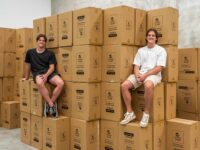 You may have noticed fun and sometimes mind-blowing virtual and augmented reality popping up in entertainment, real-estate, gaming and tourism to name a few industries. There is huge potential for retail and FMCG brands as well to embrace new technology too in several ways, yet it has not widely penetrated into the Australian market.
You may have noticed fun and sometimes mind-blowing virtual and augmented reality popping up in entertainment, real-estate, gaming and tourism to name a few industries. There is huge potential for retail and FMCG brands as well to embrace new technology too in several ways, yet it has not widely penetrated into the Australian market.
To give a crash-course on the techniques out there: with Augmented Reality it is possible to add a layer of content to the real world when customers look at a product or flyer with their phone or tablet. With Virtual Reality special goggles like the Oculus Rift or just simple viewers made out of cardboard, lenses and a rubber band or tape (commonly known as ‘google cardboard’) the viewer enters a new world that looks as if it was real. Virtual Reality can work well for brand activations or campaigns where the viewer can sit down and take the time to explore the virtual world, while Augmented Reality is usually better suited for retail as the experience is less intrusive and can be used on the go.
Coca-Cola has made an impression where consumers could point the camera of their phone on the can via the app, which would then activate additional content – making it look like the can opens like a theatre curtain and showing a whole new world. They also partnered with Shazam earlier this month to create a drinkable billboard. The good news is that these new applications are not necessarily only for large brands with big budgets; wow-effects can be achieved at affordable cost.
McDonalds came up with an interesting way to convert a happy meal box to a virtual reality viewer similar to google cardboard. Customers just had to fold the box into the designated format and pop in their phone to see a 3D world emerging after their meal. I expect more of these inventive uses to engage customers to come up soon – and this is the time to actually start thinking of doing something like this for your brand.
Another technology newcomer in the retail sphere is the use of beacons, which are tiny receptors placed in a physical space, sending and tracking information to a nearby shop visitor. It can be used to send a push notification about a sale item, track customer activity, engage with ‘hide & seek’ type searches through the store with prizes etc., and even help in planning the store visit for large retail stores to lead the customer through the product ranges he wishes to see via the smartphone app.
All this new technology is not just there to follow a trend; it is meant to engage the audience and love the brand on the one hand, and to track and analyse customer behaviour on the other hand – killing two birds with one stone. Just as with the Coca-cola and McDonalds example, a lot more can be done with brand packaging doubling up as a starting point for a digital brand experience. And as a bonus, while the technology is tested but still new, there is still the novelty around it attracting more attention.
Victor David is Marketing Manager at Designteam and Spot AR, delivering brand activation campaigns, tradeshow stands and augmented and virtual reality experiences.















